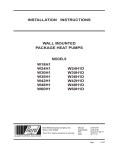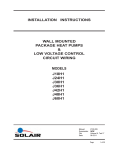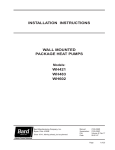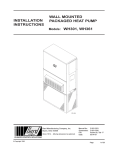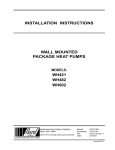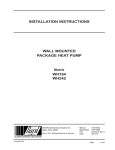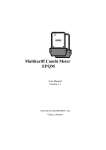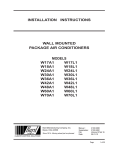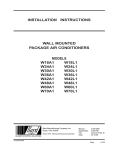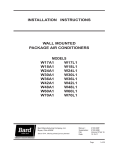Download Bard W24H1 Specifications
Transcript
INSTALLATION INSTRUCTIONS WALL MOUNTED PACKAGE HEAT PUMPS MODELS W18H1 W24H1 W30H1 W36H1 W42H1 W48H1 W60H1 Bard Manufacturing Company, Inc. Bryan, Ohio 43506 Since 1914...Moving ahead just as planned. © Copyright 2008 Manual : Supersedes: File: Date: 2100-511 NEW Volume III Tab 17 10-14-08 Manual Page 2100-511 1 of 27 Contents Getting Other Information and Publications Wall Mount General Information Wall Mount Model Nomenclature ............................ Shipping Damage .................................................... General ................................................................ Duct Work ................................................................ Filters ................................................................ Fresh Air Intake ....................................................... Condensate Drain .................................................... 3 4 4 4 5 5 5 5 Installation Instructions Wall Mounting Information ....................................... 6 Mounting the Unit .................................................... 6 Clearances Required ............................................... 6 Minimum Clearances ............................................... 6 Wiring – Main Power ............................................. 14 Wiring – Low Voltage Wiring ................................. 14 Figures Figure 1 Figure 2 Figure 3A Figure 3B Figure 3C Figure 4 Figure 5 Figure 6 Figure 7 Figure 8 Figure 9 Fresh Air Damper Assembly ................... 5 Unit Dimensions ...................................... 7 Mounting Instructions .............................. 8 Mounting Instructions - W18, W24, W30, W36 .... 9 Mounting Instructions - W42, W48, W60 ..... 10 Electric Heat Clearance ......................... 11 Wall Mounting Instructions .................... 12 Wall Mounting Instructions .................... 12 Common Wall Mounting Installations .... 13 Defrost Control Board ........................... 18 Fan Blade Setting ................................. 21 Manual 2100-511 Page 2 of 27 Start Up General .............................................................. Topping Off System Charge ................................... Safety Practices ..................................................... Important Installer Note ......................................... Wall Mounted Air Conditioner ................................ Three Phase Scroll Compressor ............................ Phase Monitor ....................................................... Condenser Fan Operation ..................................... Service Hints ......................................................... Sequence of Operation .......................................... Pressure Service Ports .......................................... Defrost Cycle ......................................................... 15 15 15 16 16 16 16 16 16 17 17 17 Troubleshooting Solid State Heat Pump Control .............................. Checking Temperature Sensor .............................. Fan Blade Setting Dimensions .............................. Removal of Fan Shroud ......................................... Refrigerant Charge ................................................ 19 20 21 21 21 Tables Table 1 Table 2 Table 3 Table 4A Table 4B Table 5 Table 6 Table 7 Tables 8 Table 9 Table 10 Table 11 Troubleshooting .................................... 19 Fan Blade Dimension ............................ 21 Refrigerant Charge ............................... 21 Cooling Pressure .................................. 22 Heating Pressure .................................. 22 Electrical Specifications W**H .............. 23 Recommended Airflow .......................... 24 Indoor Blower Performance .................. 24 Maximum ESP Electric Heat Only ........ 25 Electric Heat ......................................... 25 Optional Accessories ........................... 26 Vent & Control Options ......................... 27 GETTING OTHER INFORMATION AND PUBLICATIONS These publications can help you install the air conditioner or heat pump. You can usually find these at your local library or purchase them directly from the publisher. Be sure to consult current edition of each standard. FOR MORE INFORMATION, CONTACT THESE PUBLISHERS: ACCA Air Conditioning Contractors of America 1712 New Hampshire Ave. N.W. Washington, DC 20009 Telephone: (202) 483-9370 Fax: (202) 234-4721 ANSI American National Standards Institute 11 West Street, 13th Floor New York, NY 10036 Telephone: (212) 642-4900 Fax: (212) 302-1286 National Electrical Code ...................... ANSI/NFPA 70 Standard for the Installation .............. ANSI/NFPA 90A of Air Conditioning and Ventilating Systems Standard for Warm Air ...................... ANSI/NFPA 90B Heating and Air Conditioning Systems Load Calculation for ............................ ACCA Manual J Residential Winter and Summer Air Conditioning Duct Design for Residential .............. ACCA Manual D Winter and Summer Air Conditioning and Equipment Selection ASHRAE American Society of Heating, Refrigeration and Air Conditioning Engineers, Inc. 1791 Tullie Circle, N.E. Atlanta, GA 30329-2305 Telephone: (404) 636-8400 Fax: (404) 321-5478 NFPA National Fire Protection Association Batterymarch Park P.O. Box 9101 Quincy, MA 02269-9901 Telephone: (800) 344-3555 Fax: (617) 984-7057 Manufactured under the following U.S. Patent numbers: 5,485,878; 5,301,777; 5,002,116; 4,924,934; 4,875,520; 4,825,936 Manual Page 2100-511 3 of 27 WALL MOUNT GENERAL INFORMATION HEAT PUMP WALL MOUNT MODEL NOMENCLATURE W 42 H 1 – A 10 X X X X KW CAPACITY 18 - 1½ Ton 24 - 2 Ton 30 - 2½ Ton 36 - 3 Ton 42 - 3½ Ton 48 - 4 Ton 60 - 5 Ton VOLTS & PHASE A - 230/208/60/1 B - 230/208/60/3 C - 460/60/3 H - Heat Pump VENTILATION OPTIONS X - Barometric Fresh Air Damper (Standard) B - Blank-off Plate M - Motorized Fresh Air Damper V - Commercial Ventilator - Motorized with Exhaust E - Economizer (Internal) - Fully Modulating with Exhaust R - Energy Recovery Ventilator - Motorized with Exhaust (See Spec. Sheet S3398) A CONTROL MODULES (See Spec. Sheet S3397) REVISIONS MODEL NUMBER X COIL OPTIONS X - Standard COLOR OPTIONS 1 - Phenolic Coated Evaporator X - Beige (Standard) 2 - Phenolic Coated Condenser 1 - White 3 - Phenolic Coated Evaporator 2 - Mesa Tan and Condenser 4 - Buckeye Gray 5 - Desert Brown OUTLET OPTIONS 8 - Dark Bronze X - Front (Standard) T - Top Outlet (W30H, W36H Only) FILTER OPTIONS X - One Inch Throwaway (Standard) W - One Inch Washable P - Two Inch Pleated NOTE: Vent options X, B and M are without exhaust capability. May require separate field supplied barometric relief in building. SHIPPING DAMAGE Upon receipt of equipment, the carton should be checked for external signs of shipping damage. If damage is found, the receiving party must contact the last carrier immediately, preferably in writing, requesting inspection by the carrier’s agent. GENERAL The equipment covered in this manual is to be installed by trained, experienced service and installation technicians. The refrigerant system is completely assembled and charged. All internal wiring is complete. The unit is designed for use with or without duct work. Flanges are provided for attaching the supply and return ducts. These instructions explain the recommended method to install the air cooled self-contained unit and the electrical wiring connections to the unit. Manual 2100-511 Page 4 of 27 These instructions and any instructions packaged with any separate equipment required to make up the entire air conditioning system should be carefully read before beginning the installation. Note particularly “Starting Procedure” and any tags and/or labels attached to the equipment. While these instructions are intended as a general recommended guide, they do not supersede any national and/or local codes in any way. Authorities having jurisdiction should be consulted before the installation is made. See Page 3 for information on codes and standards. Size of unit for a proposed installation should be based on heat loss/gain calculation made according to methods of Air Conditioning Contractors of America (ACCA). The air duct should be installed in accordance with the Standards of the National Fire Protection Association for the Installation of Air Conditioning and Ventilating Systems of Other Than Residence Type, NFPA No. 90A, and Residence Type Warm Air Heating and Air Conditioning Systems, NFPA No. 90B. Where local regulations are at a variance with instructions, installer should adhere to local codes. DUCT WORK FILTERS All duct work, supply and return, must be properly sized for the design airflow requirement of the equipment. Air Conditioning Contractors of America (ACCA) is an excellent guide to proper sizing. All duct work or portions thereof not in the conditioned space should be properly insulated in order to both conserve energy and prevent condensation or moisture damage. A 1-inch throwaway filter is standard with each unit. The filter slides into position making it easy to service. This filter can be serviced from the outside by removing the filter access panel. A 1-inch washable filter and 2inch pleated filter are also available as optional accessories. The internal filter brackets are adjustable to accommodate the 2-inch filter by bending two (2) tabs down on each side of the filter support bracket. Refer to Maximum ESP of operation Electric Heat Tables 8. Design the duct work according to methods given by the Air Conditioning Contractors of America (ACCA). When duct runs through unheated spaces, it should be insulated with a minimum of one inch of insulation. Use insulation with a vapor barrier on the outside of the insulation. Flexible joints should be used to connect the duct work to the equipment in order to keep the noise transmission to a minimum. Models W18 & W24 are approved for zero inch clearance to the supply duct. For model series W30, W36, W42, W48 and W60 a 1/4 inch clearance to combustible material for the first three feet of duct attached to the outlet air frame is required. See Wall Mounting Instructions and Figures 3 and 4 for further details. Ducts through the walls must be insulated and all joints taped or sealed to prevent air or moisture entering the wall cavity. Some installations may not require any return air duct. A metallic return air grille is required with installations not requiring a return air duct. The spacing between louvers on the grille shall not be larger than 5/8 inch. Any grille that meets with 5/8 inch louver criteria may be used. It is recommended that Bard Return Air Grille Kit RG2 through RG5 or RFG2 through RFG5 be installed when no return duct is used. Contact distributor or factory for ordering information. If using a return air filter grille, filters must be of sufficient size to allow a maximum velocity of 400 fpm. FRESH AIR INTAKE All units are built with fresh air inlet slots punched in the service door. If the unit is equipped with a fresh air damper assembly, the assembly is shipped already attached to the unit. The damper blade is locked in the closed position. To allow the damper to operate, the maximum and minimum blade position stops must be installed. See Figure 1. All capacity, efficiency and cost of operation information is based upon the fresh air blank-off plate in place and is recommended for maximum energy efficiency. The blank-off plate is available upon request from the factory and is installed in place of the fresh air damper shipped with each unit. CONDENSATE DRAIN A plastic drain hose extends from the drain pan at the top of the unit down to the unit base. There are openings in the unit base for the drain hose to pass through. In the event the drain hose is connected to a drain system of some type, it must be an open or vented type system to assure proper drainage. NOTE: If no return air duct is used, applicable installation codes may limit this cabinet to installation only in a single story structure. FIGURE 1 FRESH AIR DAMPER Manual Page 2100-511 5 of 27 INSTALLATION INSTRUCTIONS WALL MOUNTING INFORMATION 1. Two holes for the supply and return air openings must be cut through the wall as shown in Figure 3. 2. On wood frame walls, the wall construction must be strong and rigid enough to carry the weight of the unit without transmitting any unit vibration. 3. Concrete block walls must be thoroughly inspected to insure that they are capable of carrying the weight of the installed unit. WARNING Failure to provide the 1/4 inch clearance between the supply duct and a combustible surface for the first 3 feet of duct can result in fire causing damage, injury or death. MOUNTING THE UNIT 1. These units are secured by wall mounting brackets which secure the unit to the outside wall surface at both sides. A bottom mounting bracket, attached to skid for shipping, is provided for ease of installation, but is not required. 2. The unit itself is suitable for 0 inch clearance, but the supply air duct flange and the first 3 feet of supply air duct require a minimum of 1/4 inch clearance to combustible material for model series W30, W36, W42, W48 and W60. However, it is generally recommended that a 1-inch clearance is used for ease of installation and maintaining the required clearance to combustible material. See Figure 3 for details on opening sizes. 3. Locate and mark lag bolt locations and bottom mounting bracket location. See Figure 3. 6. Position unit in opening and secure with 5/16 lag bolts; use 7/8 inch diameter flat washers on the lag bolts. 7. Secure rain flashing to wall and caulk across entire length of top. See Figure 3. 8. For additional mounting rigidity, the return air and supply air frames or collars can be drilled and screwed or welded to the structural wall itself (depending upon wall construction). Be sure to observe required clearance if combustible wall. 9. On side-by-side installations, maintain a minimum of 20 inches clearance on right side to allow access to control panel and heat strips, and to allow proper airflow to the outdoor coil. Additional clearance may be required to meet local or national codes. 4. Mount bottom mounting bracket. 5. Hook top rain flashing, attached to front - right of supply flange for shipping, under back bend of top. Clearances Required for Service Access and Adequate Condenser Airflow MODELS W18H, W24H, W30H, W36H W42H, W48H, W60H Manual 2100-511 Page 6 of 27 LEFT SIDE 15" 20" RIGHT SIDE 20" 20" M inimum Clearances Required to Combustible M aterials MODELS W18H / W24H W30H / W36H W42H / W48H / W60H SUPPLY AIR DUCT CABINET FIRST THREE FEET 0" 0" 1/4" 0" 1/4" 0" FIGURE 2 Dimensions of Basic Unit for Architectural and I nstallation Requirements (Nominal) MODEL WIDTH DEPTH HEIGHT SUPPLY (W) (D) (H) A B RETURN C B E F G I J K L M N O P Q R S T W18H1 33.300 W24H1 17.125 70.563 7.88 19.88 11.88 19.88 35.00 18.50 25.75 20.56 26.75 28.06 29.25 27.00 2.63 34.13 22.06 10.55 5.00 12.00 5.00 W30H1 38.200 W36H1 17.125 70.563 7.88 27.88 13.88 27.88 40.00 18.50 25.75 17.93 26.75 28.75 29.25 27.00 2.63 39.13 22.75 9.14 5.00 12.00 5.00 W42H1 42.075 W48H1 22.432 84.875 9.88 29.88 15.88 29.88 43.88 19.10 31.66 30.00 32.68 26.94 34.69 32.43 3.37 43.00 23.88 10.00 1.44 16.00 1.88 W60H1 42.075 22.432 94.875 9.88 29.88 15.88 29.88 43.88 19.10 41.66 30.00 42.68 26.94 44.69 42.43 3.37 43.00 33.88 10.00 1.44 16.00 1.88 All dimensions are in inches. Dimensional drawings are not to scale. W**H RIGHT UNIT FRONT VIEW SIDE VIEW BACK VIEW *Optional top outlet (factory installed only) for W30H and W36H models only. Manual Page 2100-511 7 of 27 Manual 2100-511 Page 8 of 27 FIGURE 3A W18H1, W24H1 MOUNTING INSTRUCTIONS Manual Page 2100-511 9 of 27 FIGURE 3B W30H1, W36H1 MOUNTING INSTRUCTIONS Manual 2100-511 Page 10 of 27 FIGURE 3C W42H1, W48H1, W60H1 MOUNTING INSTRUCTIONS FIGURE 4 ELECTRIC HEAT CLEARANCE W30H1, W36H1, W42H1, W48H1, W60H1 SIDE SECTION VIEW OF SUPPLY AIR DUCT FOR WALL MOUNTED UNIT SHOWING 1/4 INCH CLEARANCE TO COMBUSTIBLE SURFACES. WARNING A minimum of 1/4 inch clearance must be maintained between the supply air duct and combustible materials. This is required for the first 3 feet of ducting. It is important to insure that the 1/4 inch minimum spacing is maintained at all points. Failure to do this could result in overheating the combustible material and may result in a fire causing damage, injury or death. Manual Page 2100-511 11 of 27 FIGURE 5 WALL MOUNTING INSTRUCTIONS SEE FIGURE 3 – MOUNTING INSTRUCTIONS FIGURE 6 WALL MOUNTING INSTRUCTIONS SEE UNIT DIMENSIONS, FIGURE 2, FOR ACTUAL DIMENSIONS IF REQUIRED IF REQUIRED Manual 2100-511 Page 12 of 27 FIGURE 7 COMMON WALL MOUNTING INSTALLATIONS Manual Page 2100-511 13 of 27 WIRING – MAIN POWER WIRING – LOW VOLTAGE WIRING Refer to the unit rating plate for wire sizing information and maximum fuse or “HACR” type circuit breaker size. Each outdoor unit is marked with a “Minimum Circuit Ampacity”. This means that the field wiring used must be sized to carry that amount of current. Depending on the installed KW of electric heat, there may be two field power circuits required. If this is the case, the unit serial plate will so indicate. All models are suitable only for connection with copper wire. Each unit and/or wiring diagram will be marked “Use Copper Conductors Only”. These instructions must be adhered to. Refer to the National Electrical Code (NEC) for complete current carrying capacity data on the various insulation grades of wiring material. All wiring must conform to NEC and all local codes. 230/208V, 1 phase and 3 phase equipment dual primary voltage transformers. All equipment leaves the factory wired on 240V tap. For 208V operation, reconnect from 240V to 208V tap. The acceptable operating voltage range for the 240 and 208V taps are: The electrical data lists fuse and wire sizes (75° C copper) for all models including the most commonly used heater sizes. Also shown are the number of field power circuits required for the various models with heaters. The unit rating plate lists a “Maximum Time Delay Relay Fuse” or “HACR” type circuit breaker that is to be used with the equipment. The correct size must be used for proper circuit protection and also to assure that there will be no nuisance tripping due to the momentary high starting current of the compressor motor. The disconnect access door on this unit may be locked to prevent unauthorized access to the disconnect. To convert for the locking capability, bend the tab located in the bottom left-hand corner of the disconnect opening under the disconnect access panel straight out. This tab will now line up with the slot in the door. When shut, a padlock may be placed through the hole in the tab preventing entry. See “Start Up” section for important information on three phase scroll compressor start ups. See Table 5 for Electrical Specifications. Manual 2100-511 Page 14 of 27 TAP 240 208 RANGE 253 – 216 220 – 187 NOTE: The voltage should be measured at the field power connection point in the unit and while the unit is operating at full load (maximum amperage operating condition). For wiring size and connections, refer to Wiring Manual 2100-507. START UP THESE UNITS REQUIRE R-410A REFRIGERANT AND POLYOL ESTER OIL. REMEMBER: When adding R-410A refrigerant, it must come out of the charging cylinder/tank as a liquid to avoid any fractionation, and to insure optimal system performance. Refer to instructions for the cylinder that is being utilized for proper method of liquid extraction. GENERAL: 1. Use separate service equipment to avoid cross contamination of oil and refrigerants. 2. Use recovery equipment rated for R-410A refrigerant. 3. Use manifold gauges rated for R-410A (800 psi/250 psi low). WARNING Failure to conform to these practices could lead to damage, injury or death. 4. R-410A is a binary blend of HFC-32 and HFC-125. 5. R-410A is nearly azeotropic - similar to R-22 and R-12. Although nearly azeotropic, charge with liquid refrigerant. 6. R-410A operates at 40-70% higher pressure than R-22, and systems designed for R-22 cannot withstand this higher pressure. 7. R-410A has an ozone depletion potential of zero, but must be reclaimed due to its global warming potential. 8. R-410A compressors use Polyol Ester oil. 9. Polyol Ester oil is hygroscopic; it will rapidly absorb moisture and strongly hold this moisture in the oil. 10. A liquid line dryer must be used - even a deep vacuum will not separate moisture from the oil. 11. Limit atmospheric exposure to 15 minutes. 12. If compressor removal is necessary, always plug compressor immediately after removal. Purge with small amount of nitrogen when inserting plugs. TOPPING OFF SYSTEM CHARGE If a leak has occurred in the system, Bard Manufacturing recommends reclaiming, evacuating (see criteria above), and charging to the nameplate charge. If done correctly, topping off the system charge can be done without problems. With R-410A, there are no significant changes in the refrigerant composition during multiple leaks and recharges. R-410A refrigerant is close to being an azeotropic blend (it behaves like a pure compound or single component refrigerant). The remaining refrigerant charge, in the system, may be used after leaks have occurred and then “top-off” the charge by utilizing the charging charts on the inner control panel cover as a guideline. SAFETY PRACTICES: 1. Never mix R-410A with other refrigerants. 2. Use gloves and safety glasses, Polyol Ester oils can be irritating to the skin, and liquid refrigerant will freeze the skin. 3. Never use air and R-410A to leak check; the mixture may become flammable. 4. Do not inhale R-410A – the vapor attacks the nervous system, creating dizziness, loss of coordination and slurred speech. Cardiac irregularities, unconsciousness and ultimate death can result from breathing this concentration. 5. Do not burn R-410A. This decomposition produces hazardous vapors. Evacuate the area if exposed. 6. Use only cylinders rated DOT4BA/4BW 400. 7. Never fill cylinders over 80% of total capacity. 8. Store cylinders in a cool area, out of direct sunlight. 9. Never heat cylinders above 125°F. 10. Never trap liquid R-410A in manifold sets, gauge lines or cylinders. R-410A expands significantly at warmer temperatures. Once a cylinder or line is full of liquid, any further rise in temperature will cause it to burst. Manual Page 2100-511 15 of 27 START UP (Continued) IMPORTANT INSTALLER NOTE PHASE MONITOR For improved start up performance wash the indoor coil with a dish washing detergent. All units with three phase scroll compressors are equipped with a 3 phase line monitor to prevent compressor damage due to phase reversal. HIGH & LOW PRESSURE SWITCH All W**H wall mounted air conditioner series models are supplied with a remote reset for the high and low pressure switch. If tripped, this pressure switch may be reset by turning the thermostat off then back on again. THREE PHASE SCROLL COMPRESSOR START UP INFORMATION Scroll compressors, like several other types of compressors, will only compress in one rotational direction. Direction of rotation is not an issue with single phase compressors since they will always start and run in the proper direction. However, three phase compressors will rotate in either direction depending upon phasing of the power. Since there is a 50-50 chance of connecting power in such a way as to cause rotation in the reverse direction, verification of proper rotation must be made. Verification of proper rotation direction is made by observing that suction pressure drops and discharge pressure rises when the compressor is energized. Reverse rotation also results in an elevated sound level over that with correct rotation, as well as substantially reduced current draw compared to tabulated values. Verification of proper rotation must be made at the time the equipment is put into service. If improper rotation is corrected at this time, there will be no negative impact on the durability of the compressor. However, reverse operation for over one hour may have a negative impact on the bearing due to oil pump out. NOTE: If compressor is allowed to run in reverse rotation for several minutes, the compressor’s internal protector will trip. All three phase ZP compressors are wired identically internally. As a result, once the correct phasing is determined for a specific system or installation, connecting properly phased power leads to the same Fusite terminal should maintain proper rotation direction. The direction of rotation of the compressor may be changed by reversing any two line connections to the unit. Manual 2100-511 Page 16 of 27 The phase monitor in this unit is equipped with two LEDs. If the Y signal is present at the phase monitor and phases are correct the green LED will light. If phases are reversed, the red fault LED will be lit and compressor operation is inhibited. If a fault condition occurs, reverse two of the supply leads to the unit. Do not reverse any of the unit factory wires as damage may occur. CONDENSER FAN OPERATION Applies to W42, W48 and W60 models only. The condenser fan motor on 230/208 volt, one and three phase, 60 HZ units is a two-speed motor that comes factory wired on high speed for peak performance. If ambient conditions permit, it can be reconnected to low speed (red wire) for lower sound level. See wiring diagram. 50 HZ models must have fan wired on low speed. These models are factory wired on low speed. SERVICE HINTS 1. Caution owner/operator to maintain clean air filters at all times. Also, not to needlessly close off supply and return air registers. This reduces airflow through the system, which shortens equipment service life as well as increasing operating costs. 2. Check all power fuses or circuit breakers to be sure they are the correct rating. 3. Periodic cleaning of the outdoor coil to permit full and unrestricted airflow circulation is essential. SEQUENCE OF OPERATION COOLING – Circuit R-Y makes at thermostat pulling in compressor contactor, starting the compressor and outdoor motor. The G (indoor motor) circuit is automatically completed on any call for cooling operation or can be energized by manual fan switch on subbase for constant air circulation. HEATING – A 24V solenoid coil on reversing valve controls heating cycle operation. Two thermostat options, one allowing “Auto” changeover from cycle to cycle and the other constantly energizing solenoid coil during heating season, and thus eliminating pressure equalization noise except during defrost, are to be used. On “Auto” option a circuit is completed from R-W1 and R-Y on each heating “on” cycle, energizing reversing valve solenoid and pulling in compressor contactor starting compressor and outdoor motor. R-G also make starting indoor blower motor. Heat pump heating cycle now in operation. The second option has no “Auto” changeover position, but instead energizes the reversing valve solenoid constantly whenever the system switch on subbase is placed in “Heat” position, the “B” terminal being constantly energized from R. A Thermostat demand for heat completes R-Y circuit, pulling in compressor contactor starting compressor and outdoor motor. R-G also make starting indoor blower motor. PRESSURE SERVICE PORTS High and low pressure service ports are installed on all units so that the system operating pressures can be observed. Pressure tables can be found later in the manual covering all models. It is imperative to match the correct pressure table to the unit by model number. See Tables 4A & 4B. DEFROST CYCLE The defrost cycle is controlled by temperature and time on the solid state heat pump control. See Figure 8. When the outdoor temperature is in the lower 40°F temperature range or colder, the outdoor coil temperature is 32°F or below. This coil temperature is sensed by the coil temperature sensor mounted near the bottom of the outdoor coil. Once coil temperature reaches 30°F or below, the coil temperature sensor sends a signal to the control logic of the heat pump control and the defrost timer will start. After 60 minutes at 30°F or below, the heat pump control will place the system in the defrost mode. During the defrost mode, the refrigerant cycle switches back to the cooling cycle, the outdoor motor stops, electric heaters are energized, and hot gas passing through the outdoor coil melts any accumulated frost. When the temperature rises to approximately 57°F, the coil temperature sensor will send a signal to the heat pump control which will return the system to heating operations automatically. If some abnormal or temporary condition such as a high wind causes the heat pump to have a prolonged defrost cycle, the heat pump control will restore the system to heating operation automatically after 10 minutes. The heat pump defrost control board has an option of 30, 60 or 90-minute setting. All models are shipped from the factory on the 60-minute pin. If special circumstances require a change to another time, remove the wire from the 60-minute terminal and reconnect to the desired terminal. The manufacturer’s recommendation is for 60-minute defrost cycles. Refer to Figure 8. There is a cycle speed up jumper on the control. This can be used to reduce the time between defrost cycle operation without waiting for time to elapse. Use a small screwdriver or other metallic object, or another ¼ inch QC, to short between the SPEEDUP terminals to accelerate the HPC timer and initiate defrost. Be careful not to touch any other terminals with the instrument used to short the SPEEDUP terminals. It may take up to 10 seconds with the SPEEDUP terminals shorted for the speedup to be completed and the defrost cycle to start. As soon as the defrost cycle kicks in remove the shorting instrument from the SPEEDUP terminals. Otherwise the timing will remain accelerated and run through the 1-minute minimum defrost length sequence in a matter of seconds and will automatically terminate the defrost sequence. There is an initiate defrost jumper (sen jump) on the control that can be used at any outdoor ambient during the heating cycle to simulate a 0° coil temperature. This can be used to check defrost operation of the unit without waiting for the outdoor ambient to fall into the defrost region. By placing a jumper across the SEN JMP terminals (a ¼ inch QC terminal works best) the defrost sensor mounted on the outdoor coil is shunted out and will activate the timing circuit. This permits the defrost cycle to be checked out in warmer weather conditions without the outdoor temperature having to fall into the defrost region. In order to terminate the defrost test the SEN JMP jumper must be removed. If left in place too long, the compressor could stop due to the high pressure control opening because of high pressure condition created by operating in the cooling mode with outdoor fan off. Pressure will rise fairly fast as there is likely no actual frost on the outdoor coil in this artificial test condition. There is also a 5-minute compressor time delay function built into the HPC. This is to protect the compressor from short cycling conditions. In some instances, it is helpful to the service technician to override or speed up this timing period, and shorting out the SPEEDUP terminals for a few seconds can do this. Manual Page 2100-511 17 of 27 FIGURE 8 DEFROST CONTROL BOARD Manual 2100-511 Page 18 of 27 TROUBLESHOOTING SOLID STATE HEAT PUMP CONTROL TROUBLESHOOTING PROCEDURE 1. NOTE: A thorough understanding of the defrost cycle sequence is essential. Review that section earlier in this manual prior to troubleshooting the control. Turn on AC power supply to unit. 2. Turn thermostat blower switch to “fan on” – the indoor blower should start. (If it doesn’t, troubleshoot indoor unit and correct problem.) 3. Turn thermostat blower to “auto” position. Indoor blower should stop. NOTE: Many models have a 1-minute blower time delay on “off” command; wait for this to time-out. 4. Set system switch to “heat” or “cool”. Adjust thermostat to call for heat or cool. The indoor blower, compressor and outdoor fan should start. NOTE: If there was no power to 24 volt transformer, the compressor and outdoor fan motor will not start for 5 minutes. This is because of the compressor short cycle protection. TABLE 1 TROUBLESHOOTING Symptom Compressor will not start (heating or cooling) Possible Causes Check for 24V from R to C on the heat pump control What & How to Check / Repair If 24V is not present at R, check wiring from board to transformer and check transformer input and output voltage. If transformer has no 24V output, determine cause and replace transformer. Check for 24V from Y to C If 24V is not present, check thermostat and thermostat wiring, outdoor thermostat (if equipped) on low voltage terminal strip phase monitor (if equipped, used on some 3-phase models). If 24V is present continue to next step. Check for 24V from C to CC on heat pump control If 24V is present, check and/or replace compressor contactor. If 24V is not present, jump the speed up terminal for 10 seconds. If compressor does not start check for 24V from C to L1 on the heat pump control. Compressor lock out If 24V is not present at L1 of the heat pump control, check the high pressure switch and low pressure bypass relay (if equipped) and all associated wiring and terminals. The safety circuit is a closed circuit. If the high pressure switch or low pressure bypass relay are open, the control will lock out the compressor. Replace defective component. Cycle power off and on to reset lock out. Jump speed up terminals for 10 seconds to override 5-minute time delay. Defective heat pump control If 24V is present from C to Y, and C to L1 on the heat pump control, the time delay has been overridden or expired and no 24V is present at CC, replace the heat pump control. Fan outdoor motor Heat pump control defective does not run (cooling or heating Motor defective except during Motor capacitor defective defrost) Reversing valve does not energize (heating only) Check across fan relay on heat pump control. (Com-NC) Replace heat pump control. Check for open or shorted motor winding. Replace motor. Check capacitor rating. Check for open or shorted capacitor. Replace capacitor. Heat pump control defective Check for 24V between RV-C and B-C. 1. Check control circuit wiring. 2. Replace heat pump control Reversing valve solenoid coil defective Check for open or shorted coil. Replace solenoid coil. Unit will not go into defrost (heating only) Temperature sensor or heat Disconnect temperature sensor from board and jumper across "SPEEDUP" terminals and "SEN pump control defective JMP" terminals. This should cause the unit to go through a defrost cycle within one minute. 1. If unit goes through defrost cycle, replace temperature sensor. 2. If unit does not go through defrost cycle, replace heat pump control. Unit will not come out of defrost (heating only) Temperature sensor or heat Jumper across "SPEEDUP" terminal. pump control defective. This should cause the unit to come out of defrost within one minute. 1. If unit comes out of defrost cycle, replace temperature sensor. 2. If unit does not come out of defrost cycle, replace heat pump control. Manual Page 2100-511 19 of 27 CHECKING TEMPERATURE SENSOR OUTSIDE UNIT CIRCUIT 1. Disconnect temperature sensor from board and from outdoor coil. 2. Use an ohmmeter and measure the resistance of the sensor. Also use ohmmeter to check for short or open. 3. Check resistance reading to chart of resistance. Use sensor ambient temperature. (Tolerance of part is ± 10%.) 4. If sensor resistance reads very low, then sensor is shorted and will not allow proper operation of the heat pump control. 5. If sensor is out of tolerance, shorted, open or reads very low ohms then it should be replaced. TEMPERATURE F VS. RESISTANCE R OF TEMPERATURE SENSOR F -25.0 -24.0 -23.0 -22.0 -21.0 -20.0 -19.0 -18.0 -17.0 -16.0 -15.0 -14.0 -13.0 -12.0 -11.0 -10.0 -9.0 -8.0 -7.0 -6.0 -5.0 -4.0 -3.0 -2.0 -1.0 0.0 1.0 2.0 3.0 4.0 5.0 6.0 7.0 8.0 9.0 10.0 11.0 12.0 R 196871 190099 183585 177318 171289 165487 159904 154529 149355 144374 139576 134956 130506 126219 122089 118108 114272 110575 107010 103574 100260 97064 93981 91008 88139 85371 82699 80121 77632 75230 72910 70670 68507 66418 64399 62449 60565 58745 Manual 2100-511 Page 20 of 27 F 13.0 14.0 15.0 16.0 17.0 18.0 19.0 20.0 21.0 22.0 23.0 24.0 25.0 26.0 27.0 28.0 29.0 30.0 31.0 32.0 33.0 34.0 35.0 36.0 37.0 38.0 39.0 40.0 41.0 42.0 43.0 44.0 45.0 46.0 47.0 48.0 49.0 50.0 R 56985 55284 53640 52051 50514 49028 47590 46200 44855 43554 42295 41077 39898 38757 37652 36583 35548 34545 33574 32634 31723 30840 29986 29157 28355 27577 26823 26092 25383 24696 24030 23384 22758 22150 21561 20989 20435 19896 F 53.0 52.0 53.0 54.0 55.0 56.0 57.0 58.0 59.0 60.0 61.0 62.0 63.0 64.0 65.0 66.0 67.0 68.0 69.0 70.0 71.0 72.0 73.0 74.0 75.0 76.0 77.0 78.0 79.0 80.0 81.0 82.0 83.0 84.0 85.0 86.0 87.0 88.0 R 19374 18867 18375 17989 17434 16984 16547 16122 15710 15310 14921 14544 14177 13820 13474 13137 12810 12492 12183 11883 11591 11307 11031 10762 10501 10247 10000 9760 9526 9299 9077 8862 8653 8449 8250 8057 7869 7686 F 89.0 90.0 91.0 92.0 93.0 94.0 95.0 96.0 97.0 98.0 99.0 100.0 101.0 102.0 103.0 104.0 105.0 106.0 107.0 108.0 109.0 110.0 111.0 112.0 113.0 114.0 115.0 116.0 117.0 118.0 119.0 120.0 121.0 122.0 123.0 124.0 R 7507 7334 7165 7000 6840 6683 6531 6383 6239 6098 5961 5827 5697 5570 5446 5326 5208 5094 4982 4873 4767 4663 4562 4464 4367 4274 4182 4093 4006 3921 3838 3757 3678 3601 3526 3452 TROUBLESHOOTING FAN BLADE SETTING DIMENSIONS Shown in Figure 9 is the correct fan blade setting for proper air delivery across the outdoor coil. Refer to Table 2 for unit specific dimension. Any service work requiring removal or adjustment in the fan and/or motor area will require that the dimensions below be checked and blade adjusted in or out on the motor shaft accordingly. REFRIGERANT CHARGE The correct system R-410A charge is shown on the unit rating plate. Optimum unit performance will occur with a refrigerant charge resulting in a suction line temperature (6" from compressor) as shown in Table 3. If charge quantity is in doubt, reclaim unit and recharge to factory nameplate quantity. TABLE 3 REFRIGERANT CHARGE FIGURE 9 FAN BLADE SETTING TABLE 2 FAN BLADE DIMENSION Model Dimension A W18H1 W24H1 1.00" W30H1 W36H1 1.25" W42H1 W48H1 W60H1 1.75" MIS-1724 Model Rated Airflow 95°F OD 82°F OD Temperature Temperature W18H1 600 57 - 61 62 - 66 W24H1 800 58 - 62 58 - 63 W30H1 1000 58 - 62 62 - 66 W36H1 1100 58 - 62 57 - 61 W42H1 1400 61 - 65 65 - 69 W48H1 1550 60 - 64 63 - 67 W60H1 1650 60 - 64 65 - 69 The suction line temperatures in Table 3 above are based upon 80°F dry bulb / 67°F wet bulb (50% R.H.) temperature and rated airflow across the evaporator during cooling cycle. REMOVAL OF FAN SHROUD 1. Disconnect all power to the unit. 2. Remove the screws holding both grilles, one on each side of unit, and remove grilles. 3. Remove screws holding fan shroud to condenser and bottom. Nine (9) screws. 4. Unwire condenser fan motor. 5. Slide complete motor, fan blade, and shroud assembly out the left side of the unit. 6. Service motor/fan as needed. 7. Reverse steps to reinstall. Manual Page 2100-511 21 of 27 TABLE 4A COOLING PRESSURE TABLE Model W18H1 W24H1 W30H1 W36H1 W42H1 W48H1 W60H1 Air Temperature Entering Outdoor Coil °F Return Air Temperature Pressure 75 deg. D B 62 deg. WB Low S i de High Side 132 292 134 311 137 332 138 353 140 376 142 400 144 424 146 450 148 477 150 505 80 deg. D B 67 deg. WB Low S i de High Side 141 299 143 319 146 340 148 362 150 386 152 410 154 435 156 462 158 489 160 518 85 deg. D B 72 deg. WB Low S i de High Side 146 309 148 330 151 352 153 375 155 400 157 424 159 450 161 478 164 506 166 536 75 deg. D B 62 deg. WB Low S i de High Side 124 329 126 351 128 373 131 398 133 423 135 449 137 475 138 503 140 531 142 561 80 deg. D B 67 deg. WB Low S i de High Side 133 337 135 360 137 383 140 408 142 434 144 460 146 487 148 516 150 545 152 575 85 deg. D B 72 deg. WB Low S i de High Side 138 349 140 373 142 396 145 422 147 449 149 476 151 504 153 534 155 564 157 595 75 deg. D B 62 deg. WB Low S i de High Side 125 326 128 350 131 373 133 398 136 423 137 448 139 472 141 496 143 522 145 547 80 deg. D B 67 deg. WB Low S i de High Side 134 334 137 359 140 383 142 408 145 434 147 459 149 484 151 509 153 535 155 561 85 deg. D B 72 deg. WB Low S i de High Side 139 346 142 372 145 396 147 422 150 449 152 475 154 501 156 527 158 554 160 581 75 deg. D B 62 deg. WB Low S i de High Side 122 329 124 351 126 375 128 399 130 424 132 449 135 476 137 503 138 530 141 559 80 deg. D B 67 deg. WB Low S i de High Side 131 337 133 360 135 385 137 409 139 435 141 461 144 488 146 516 148 544 151 573 85 deg. D B 72 deg. WB Low S i de High Side 136 349 138 373 140 398 142 423 144 450 146 477 149 505 151 534 153 563 156 593 75 deg. D B 62 deg. WB Low S i de High Side 127 354 130 372 132 392 134 413 135 437 136 461 137 488 137 516 137 546 136 578 80 deg. D B 67 deg. WB Low S i de High Side 136 363 139 382 141 402 143 424 144 448 145 473 146 500 146 529 146 560 145 593 85 deg. D B 72 deg. WB Low S i de High Side 141 376 144 395 146 416 148 439 149 464 150 490 151 518 151 548 151 580 150 614 75 deg. D B 62 deg. WB Low S i de High Side 129 352 132 374 134 398 136 422 137 449 139 476 141 505 143 535 145 566 146 600 80 deg. D B 67 deg. WB Low S i de High Side 138 361 141 384 143 408 145 433 147 460 149 488 151 518 153 549 155 581 156 615 85 deg. D B 72 deg. WB Low S i de High Side 143 374 146 397 148 422 150 448 152 476 154 505 156 536 158 568 160 601 161 637 75 deg. D B 62 deg. WB Low S i de High Side 126 332 128 352 131 373 133 397 135 421 137 448 139 476 141 505 143 536 145 568 80 deg. D B 67 deg. WB Low S i de High Side 135 341 137 361 140 383 142 407 144 432 147 459 149 488 151 518 153 550 155 583 85 deg. D B 72 deg. WB Low S i de High Side 140 353 142 374 145 396 147 421 149 447 152 475 154 505 156 536 158 569 160 603 75 80 85 90 95 100 105 110 115 120 Low side pressure ± 4 PSIG High side pressure ± 10 PSIG Tables are based upon rated CFM (airflow) across the evaporator coil. If there is any doubt as to correct operating charge being in the system, the charge should be removed, system evacuated and recharged to serial plate charge weight. NOTE: Pressure table based on high speed condenser fan operation. If condensing pressures appear elevated check condenser fan wiring. See “Condenser Fan Operation”. TABLE 4B HEATING PRESSURES – (ALL TEMPERATURES °F) Model Return Air Temperature Pressure 0 5 10 15 20 25 30 35 40 45 50 55 60 48 290 52 285 56 282 61 282 66 285 72 290 79 297 87 307 95 319 104 334 114 352 124 372 135 394 W18H 70 deg. Low S i de High Side W24H 70 deg. Low S i de High Side 57 292 55 296 55 301 57 307 59 314 64 323 70 332 77 342 86 354 96 367 108 380 121 395 135 411 W30H 70 deg. Low S i de High Side 53 254 53 266 55 278 58 290 61 301 66 312 72 322 80 332 88 342 97 351 108 360 119 369 132 377 W36H 70 deg. Low S i de High Side 47 281 49 282 51 283 55 287 59 292 64 300 70 308 77 319 85 331 93 345 103 361 113 379 124 398 W42H 70 deg. Low S i de High Side 50 299 50 300 52 303 54 308 58 314 62 322 68 331 75 342 84 355 93 370 104 386 115 404 128 423 W48H 70 deg. Low S i de High Side 42 268 45 270 49 274 54 278 59 284 64 291 70 298 77 307 84 317 92 327 100 339 109 352 118 366 W60H 70 deg. Low S i de High Side 39 294 43 296 47 300 52 305 58 311 63 319 70 328 76 338 84 349 92 362 100 376 109 391 118 408 Manual 2100-511 Page 22 of 27 TABLE 5 Electrical Specifications — W**H Series Si ngle C i rcui t Model W18H1- A00, A0Z A 04 3 A 08 W24H1- A00, A0Z A 04 3 A 08 W24H1- B00, B0Z B 06 W24H1- C 00, C 0Z C 06 W30H1- A00, A0Z* A 05* 3 A 10* W30H1- B00, B0Z* B 06 3 B 09* W30H1- C 00, C 0Z* C 06 3 C 09* C 15 W36H1- A00, A0Z* A 05 3 A 10* 5 A 15 W36H1- B00, B0Z* B 06 3 B 09* 5 B 15 W36H1- C 00, C 0Z* C 06 3 C 09* C 15 W42H1- A00, A0Z A 05 3 A 10 5 A 15 W42H1- B00, B0Z B 06 3 B 09 5 B 15 W42H1- C 00, C 0Z C 06 3 C 09 5 C 15 W48H1- A00, A0Z A 04 A 05 3 A 10 5 A 15 5 A 20 W48H1- B00, B0Z B 06 3 B 09 5 B 15 5 B 18 W48H1- C 00, C 0Z 3 C 09 5 C 15 W60H1- A00, A0Z A 05 3 A 10 5 A 15 5 A 20 W60H1- B00, B0Z 3 B 09 5 B 15 5 B 18 W60H1- C 00, C 0Z 3 C 09 5 C 15 Rated Volts and Phase No. Fi eld Power C i rcui ts 4 Mi ni mum C i rcui t Ampaci ty 1 Maxi mum External Fuse or C kt. Brkr. 2 Fi eld Power Wi re Si ze 2 Ground Wi re 1 1 1 1 1 1 1 1 1 1 1 1 or 1 1 1 1 1 1 1 1 1 or or 1 1 1 1 1 1 1 1 1 1 or or 1 1 1 1 1 1 1 1 1 1 or or or or 1 1 1 1 or 1 1 1 1 or or or or 1 1 1 1 1 1 1 16 37 58 24 44 65 17 35 11 21 24 50 76 18 36 45 11 20 25 26 29 55 81 84 23 41 50 51 12 21 25 26 36 62 88 88 26 44 53 53 13 22 26 26 37 58 63 89 89 111 29 47 56 56 62 14 27 27 41 67 93 93 111 28 55 55 62 16 28 28 20 40 60 25 50 70 20 40 15 25 35 50 80 25 40 45 15 20 25 30 40 60 90 90 30 45 50 60 15 25 25 30 50 70 90 90 35 50 60 60 15 25 30 30 50 60 70 90 90 125 35 50 60 60 70 20 30 30 60 80 100 100 125 40 60 60 70 20 30 30 12 8 6 10 8 6 12 8 14 10 8 8 4 10 8 8 14 12 10 10 8 6 4 4 10 8 8 8 14 10 10 10 8 6 3 3 8 8 6 6 14 10 10 10 8 6 6 3 3 2 8 8 6 6 6 12 10 10 8 4 3 3 2 8 6 6 6 12 10 10 12 10 10 10 10 8 12 10 14 10 10 10 8 10 10 10 14 12 10 10 10 10 8 8 10 10 10 10 14 10 10 10 10 8 8 8 10 10 10 10 14 10 10 10 10 10 8 8 8 6 10 10 10 10 8 12 10 10 10 8 8 8 6 10 10 10 10 12 10 10 230/208-1 230/208-1 230/208-3 460-3 230/208-1 1 230/208-3 460-3 230/208-1 1 1 230/208-3 460-3 230/208-1 1 1 230/208-3 460-3 230/208-1 1 1 1 1 230/208-3 1 460-3 230/208-1 230/208-3 460-3 1 1 1 1 2 2 2 2 2 2 2 2 2 2 2 2 2 2 D ual C i rcui t 4 Mi ni mum 1 Maxi mum 2 Fi eld 2 Ground C i rcui t External Fuse Power Wi re Si ze Ampaci ty or C kt. Breaker Wi re Si ze C kt. A C kt. B C kt. A C kt. B C kt. A C kt. B C kt. A C kt. B 44 21 45 25 8 10 10 10 50 26 50 30 8 10 10 10 55 55 26 52 60 60 30 60 6 6 10 6 10 10 10 10 36 36 36 26 52 52 50 50 50 30 60 60 8 8 8 10 6 6 10 10 10 10 10 10 37 37 37 59 26 52 52 52 50 50 50 60 30 60 60 60 8 8 8 6 10 6 6 6 10 10 10 10 10 10 10 10 34 28 40 30 8 10 10 10 41 41 41 59 26 52 52 52 60 60 60 60 30 60 60 60 8 8 8 6 10 6 6 6 10 10 10 10 10 10 10 10 34 28 40 30 8 10 10 10 1 Maximum size of the time delay fuse or HACR type circuit breaker for protection of field wiring conductors. 2 Based on 75C copper wire. All wiring must conform to the National Electrical Code and all local codes. 3 These “Minimum Circuit Ampacity” values are to be used for sizing the field power conductors. Refer to the National Electrical code (latest version), Article 310 for power conductor sizing. Caution: When more than one field power circuit is run through one conduit, the conductors must be derated. Pay special attention to note 8 of Table 310 regarding Ampacity Adjustment Factors when more than three (3) current carrying conductors are in a raceway. * Top outlet supply option is available only factory installed and only on the selected models. IMPORTANT: While this electrical data is presented as a guide, it is important to electrically connect properly sized fuses and conductor wires in accordance with the National Electrical Code and all local codes. Manual Page 2100-511 23 of 27 TABLE 6 RECOMMENDED AIRFLOW Model Rated C FM * Rated ESP * Recommended Airflow Range Factory Speed Connection W18H 600 1 .30 575 - 725 High W24H 800 .20 700 - 950 High W30H 1000 .40 930 - 1300 High W36H 1100 .30 930 - 1350 High W42H 1400 .30 1600 - 1150 High W48H 1550 .20 1750 - 1285 High W60H 1650 .30 1950 - 1375 High * Rated CFM and ESP on high speed tap. 1 Rated CFM and ESP on low speed tap. TABLE 7 INDOOR BLOWER PERFORMANCE E.S.P. In H 2O .0 .1 .2 .3 .4 .5 W18H, W24H W18H High Speed L o w S p eed High Speed L o w S p eed High Speed L o w S p eed High Speed L o w S p eed Dry Coil Wet Coil Dry Coil Wet Coil Dry Coil Wet Coil Dry Coil Wet Coil Dry Coil Wet Coil Dry Coil Wet Coil Dry Coil Wet Coil Dry Coil Wet Coil 1020 960 865 820 735 615 975 905 800 735 650 535 750 735 710 660 605 540 700 675 650 600 550 490 1395 1340 1285 1205 1110 1005 1315 1270 1190 1100 1000 870 950 930 910 855 800 — 935 915 885 830 755 — 1885 1770 1635 1500 1370 1250 1800 1665 1540 1400 1285 1150 1650 1550 1450 1350 1300 — 1600 1500 1400 1300 1175 — 2200 2100 2000 1875 1775 1650 2000 1900 1800 1700 1600 1475 1600 1525 — — — — 1450 1375 — — — — Manual 2100-511 Page 24 of 27 W30H, W36H W42H, W48H W60H TABLES 8 MAXIMUM ESP OF OPERATION ELECTRIC HEAT ONLY Front Outlet Model Model S p eed K W Model ESP W18H1 W24H1 A 00 A 04 A 08 .50 .50 .40 W24H1 B 00 B 06 .50 .50 W24H1 C 00 C 06 .50 .50 Top Outlet Low S p eed High S p eed Low S p eed High S p eed W30H1 W36H1 A 00 A 05 A 10 A 15 .50 .40 .35 .35 .50 .50 .40 .40 .50 .40 .25 NA .50 .50 .40 NA W30H1 W36H1 B 00 B 06 B 09 B 15 .50 .40 .35 .35 .50 .50 .45 .45 .50 NA .30 NA .50 NA .40 NA W30H1 W36H1 C 00 C 06 C 09 C 15 .50 .50 .30 .30 .50 .50 .40 .40 .50 NA .35 NA .50 NA .45 NA W42H1 W48H1 W60H1 High Speed Low Speed High Speed Low Speed High Speed Low Speed -A00 -A04 -A05 -A10 -A15 -A20 .50 ----.50 .50 .50 ----- .50 ----.50 .45 .45 ----- .50 .50 .50 .50 .50 .50 .50 .50 .50 .45 .45 .45 .50 ----.50 .50 .50 .50 .40 ----.25 .25 .25 .25 -B00 -B09 -B15 -B18 .50 .50 .50 ----- .50 .45 .45 ----- .50 .50 .50 .50 .50 .45 .45 .45 .50 .50 .50 .50 .40 .30 .30 .30 -C00 -C09 -C15 .50 .50 .50 .50 .40 .40 .50 .50 .50 .50 .40 .40 .50 .50 .50 .40 .35 .35 TABLE 9 ELECTRIC HEAT Models 240V-1 208V-1 KW Amps B TU H Amps B TU H 4 16.7 13650 14.4 10240 5 20.8 17065 18.1 12800 6 8 33.3 27300 28.8 41.6 34130 36.2 208V-3 Amps B TU H Amps B TU H Amps B TU H 14.4 20500 12.5 15360 7.2 20500 21.7 30600 18.7 23030 10.8 30700 14.4 40950 18.0 51200 25600 12 15 62.5 51250 54.0 38400 18 20 83.2 68260 72.1 460V-3 20475 9 10 240V-3 36.2 51200 31.2 38400 43.3 61430 37.5 46100 51200 Manual Page 2100-511 25 of 27 EHWH02A-A04 X EHWH02A-A08 X EHW24H-A04 X EHW24H-A08 X EHW24H-B06 EHWH30-A05 X EHWH30-A10 X EHWH36-A05 X EHWH36-A10 X EHWH36-A15 X W60H1-C W60H1-B W60H1-A W48H1-C X EHW36H-B06 X EHWH03-B09 X X EHW30H-B15 X EHWC03A-C06 X X EHWH42-A05 X X EHWH42-A10 X X EHWH42-A15 X X EHWH-04-A20 X X EHWH05-B06 X X EHWH05-B09 X X X EHWH05-B15 X X X EHWH42-C06 X EHWH05A-C09 X X X EHWH05A-C15 X X X EHWH04-A15 X EHWH04-A10 X EHW05H-B18 CIRCUIT BREAKER (WMCB) & PULL DISCONNECT (WMPD) W48H1-B W48H1-A W42H1-C W42H1-B W42H1-A W36H1-C W36H1-B W36H1-A W30H1-C X EHWH03-B06 HEATER KITS W30H1-B W30H1-A W24H1-C W24H1-B W24H1-A Part Number W18H1-A TABLE 10 OPTIONAL ACCESSORIES WMCB-02A X X WMCB-02B WMCB-03A X X X WMCB-03B X WMCB-06A X X X WMCB-05B X X WMCB-07B X WMCB-08A X X WMCB-09A WMPD-01C Manual 2100-511 Page 26 of 27 X X X X X X X Part Number Description W18, W24 W30, W36 W42, W48, W60 TABLE 11 VENT & CONTROL OPTIONS CMC-14 ODT X X X CMC-15 Start Kit (230V 1-Phase only) 1 X X X SK111 Start Kit (230V 1-Phase only) 2 X X X CMC-28 LA C X X X BFAD-2 Barometric Fresh Air Damper - Standard X BOP-2 Blank Off Plate X MFAD-2 Motorized Fresh Air Damper X CRV-2 Commercial Ventilator - Spring Return X EIFM-2B Economizer X ERVF-A2 Energy Recovery Ventilator - 230 Volt X BFAD-3 Barometric Fresh Air Damper - Standard X BOP-3 Blank Off Plate X MFAD-3 Motorized Fresh Air Damper X CRVS-3 Commercial Ventilator - Spring Return X CRVP-3 Commercial Ventilator - Power Return X EIFM-3C Economizer X ERVF-A3 Energy Recovery Ventilator - 230 Volt X ERVF-C3 Energy Recovery Ventilator - 460 Volt X BFAD-5 Barometric Fresh Air Damper - Standard X BOP-5 Blank Off Plate X MFAD-5 Motorized Fresh Air Damper X CRVS-5 Commercial Ventilator - Spring Return X CRVP-5 Commercial Ventilator - Power Return X EIFM-5C Economizer X ERVF-A5 Energy Recovery Ventilator - 230 Volt X ERVF-C5 Energy Recovery Ventilator - 460 Volt X 1 PTCR Start Kit can be used with all -A single phase models. Increases starting torque 2-3x. Not used for -B or -C three phase models. Do not use if SK111 is used. 2 Start Capacitor and potential relay start kit can be used with all -A single phase models. Increases starting torque 9x. Not used for -B or -C three phase models. Do not use if CMC-15 is used. Manual Page 2100-511 27 of 27



























